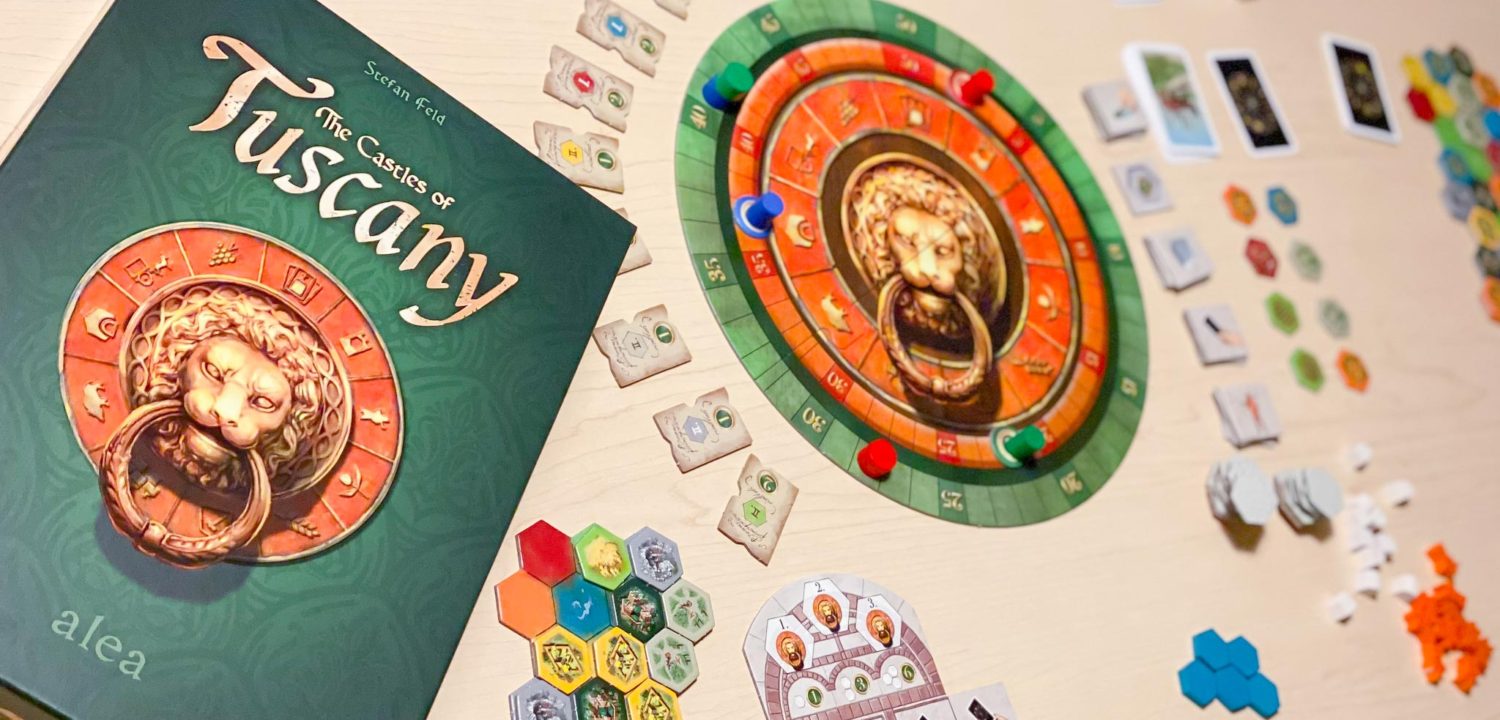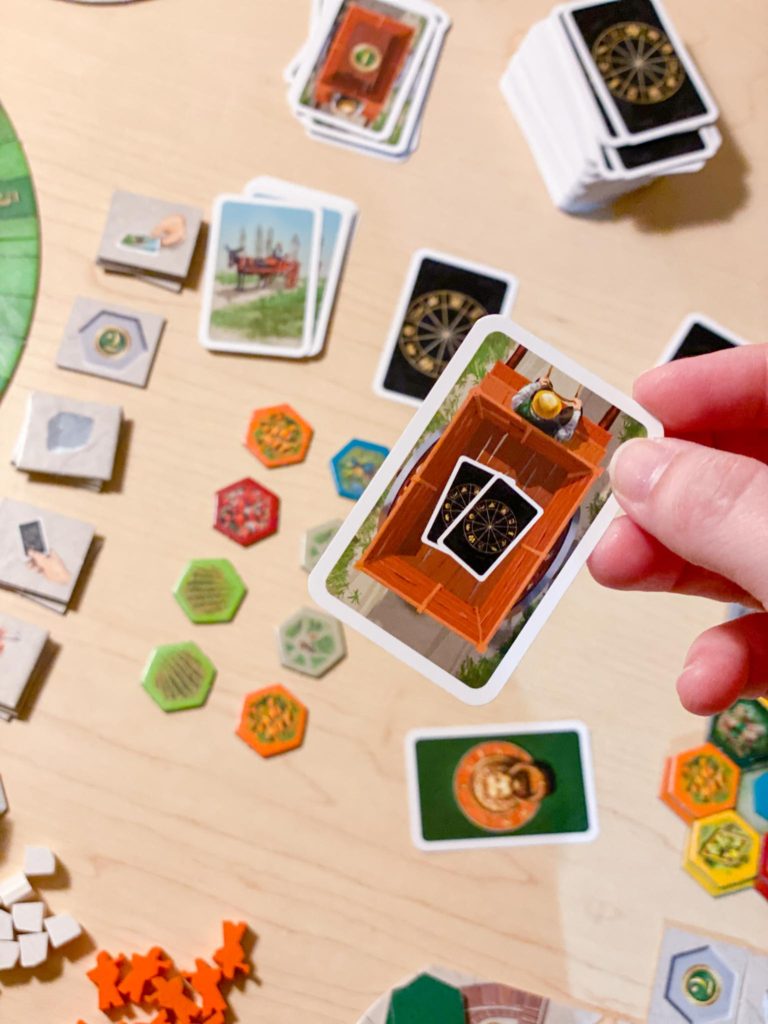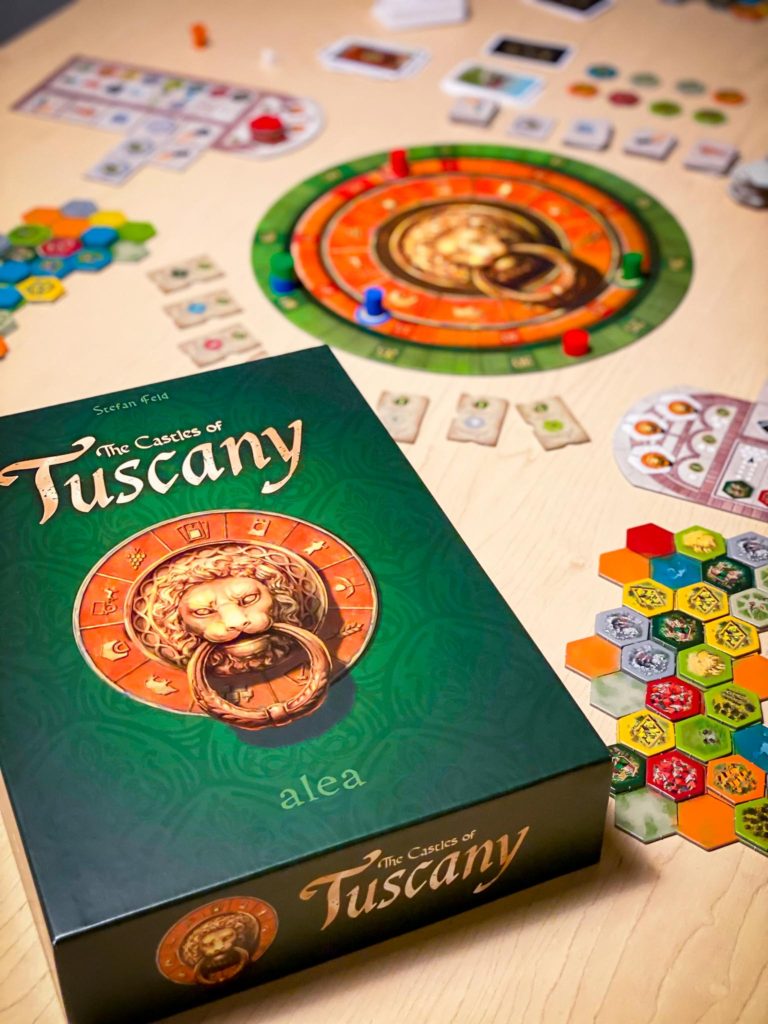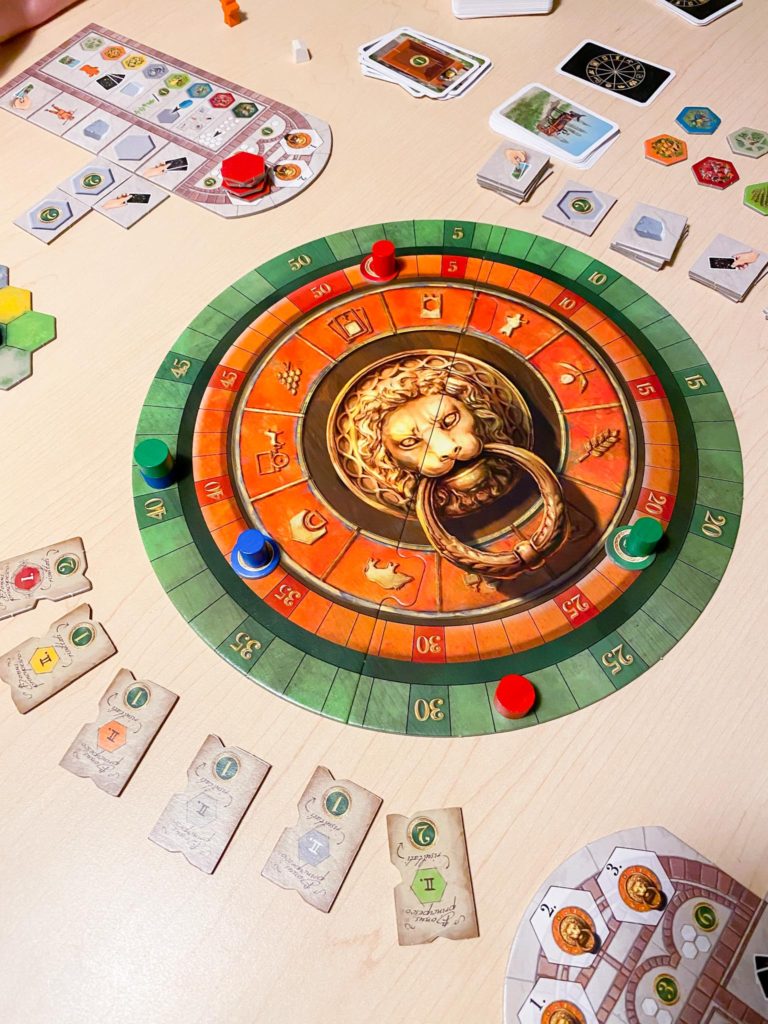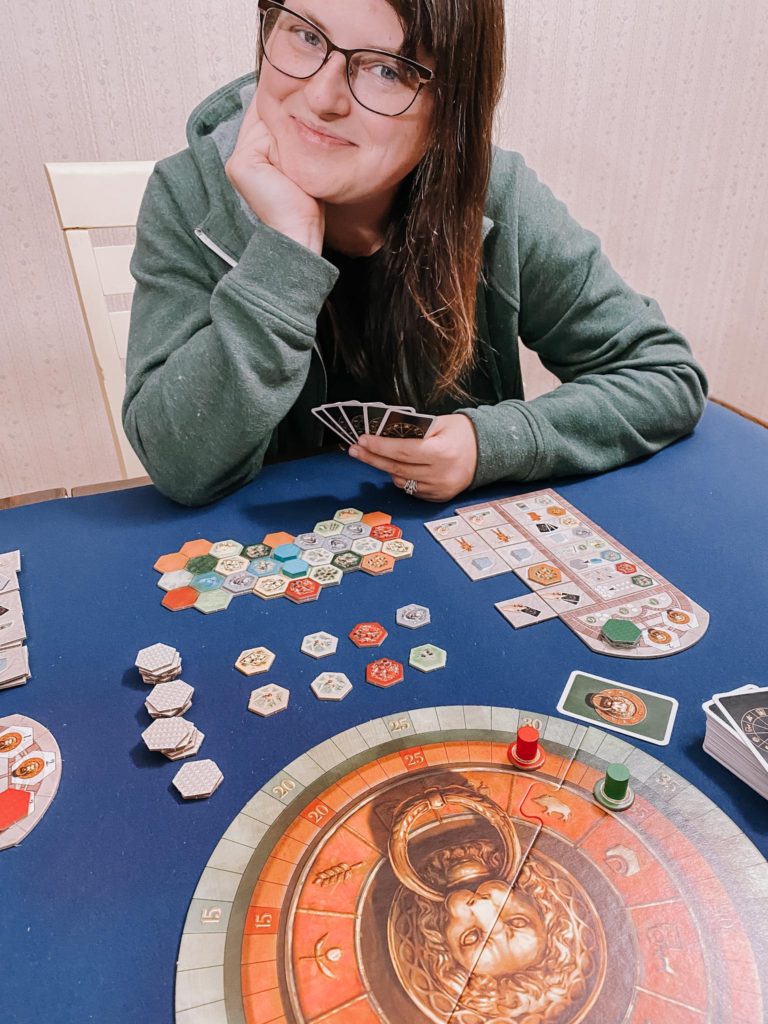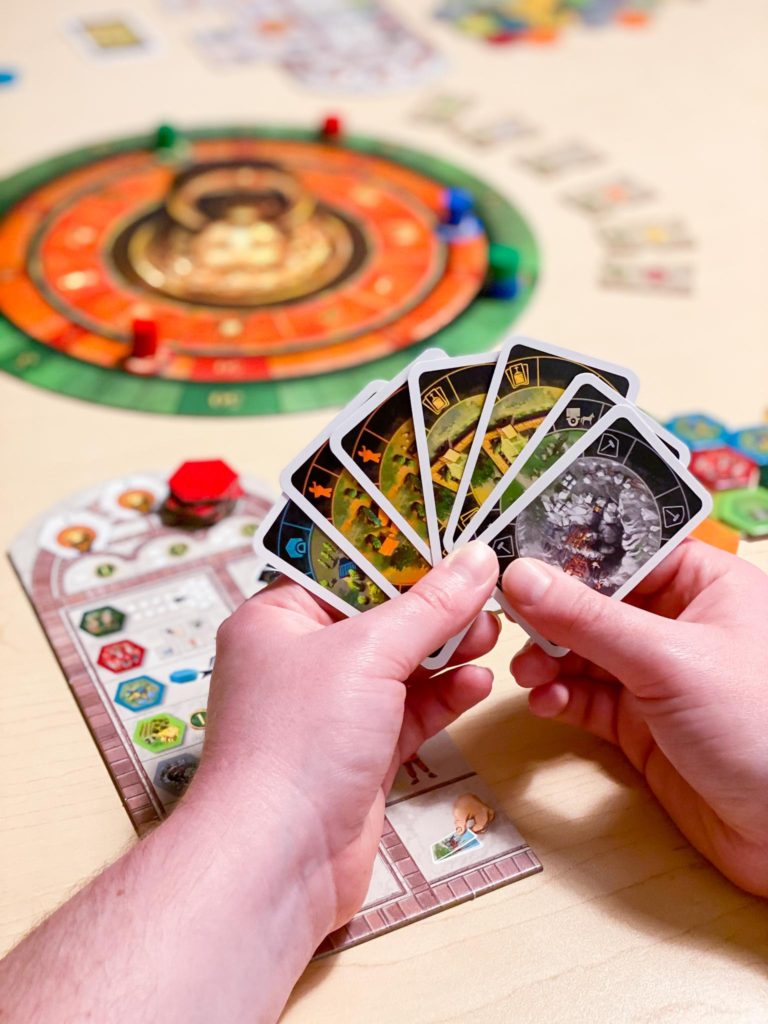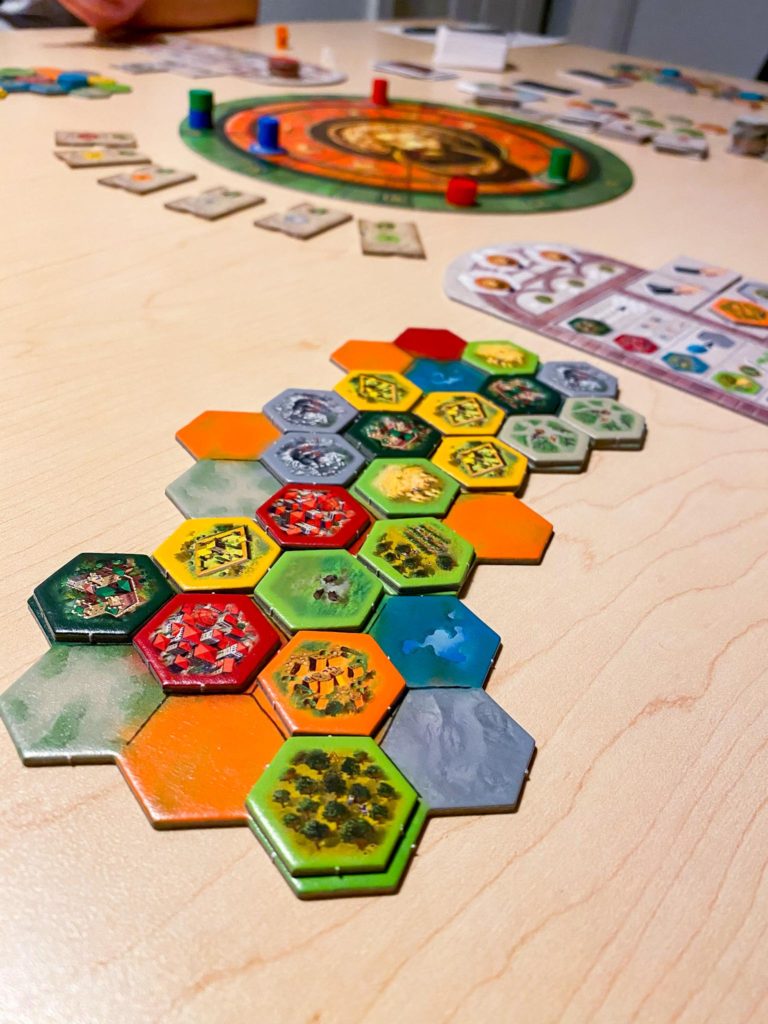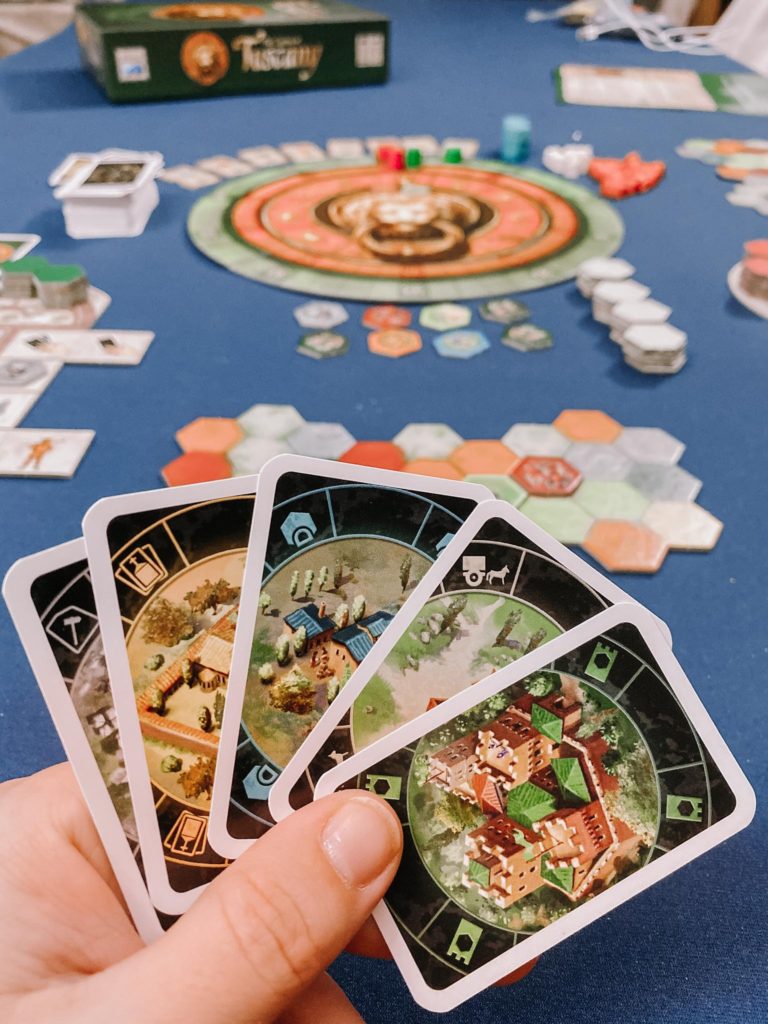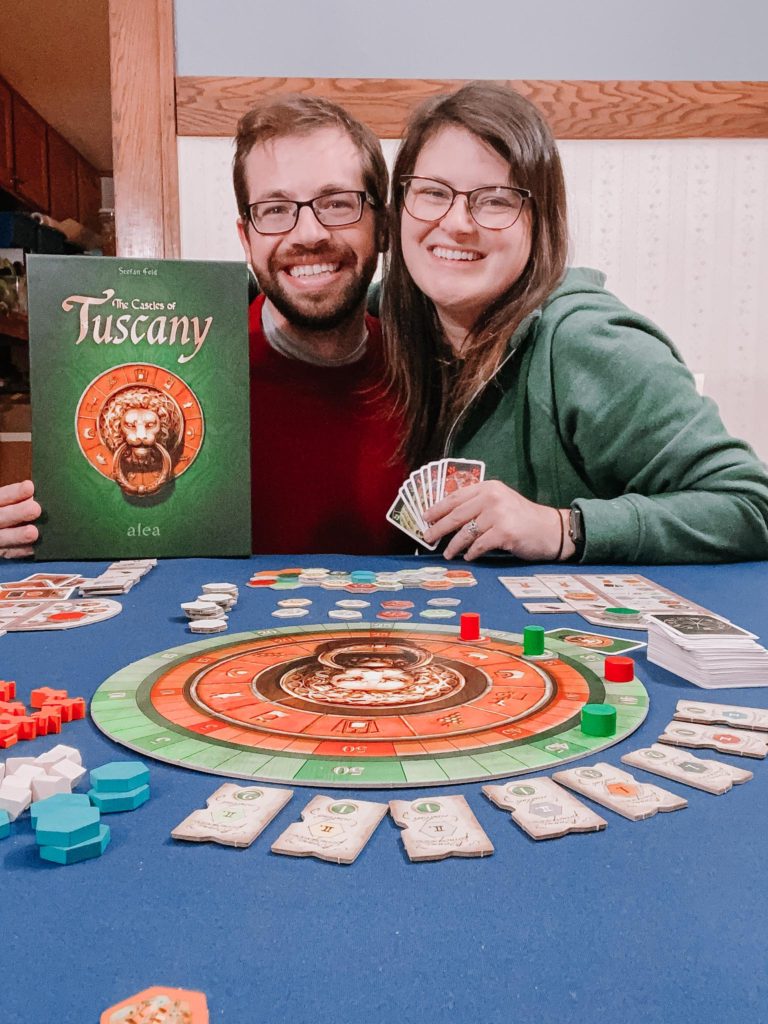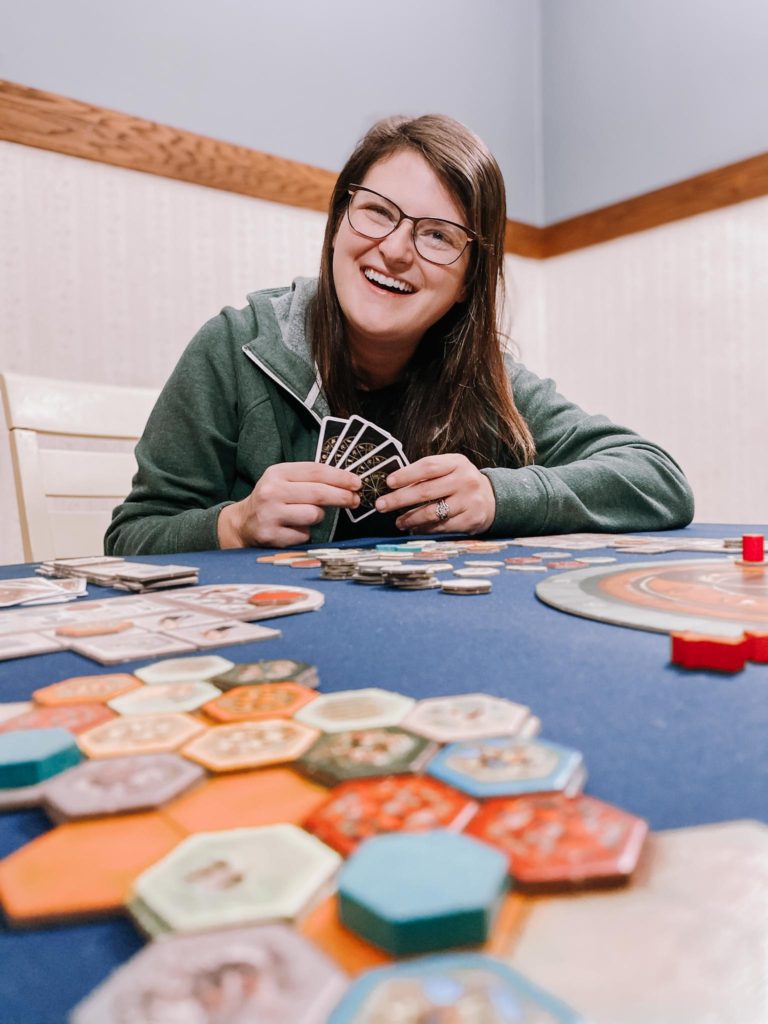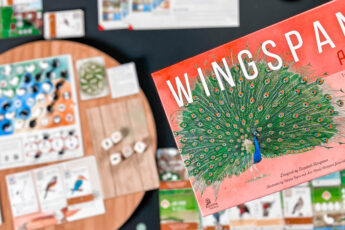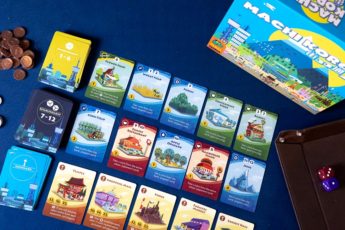The Castles of Tuscany
We’re diving deep into The Castles of Tuscany! This is a lovely and accessible strategy game from designer Stefan Feld.
What is The Castles of Tuscany?
The Castles of Tuscany is a strategy game where players are attempting to create a prosperous domain by adding tiles to their board that expands their region, earning them bonuses and victory points.
How Do You Play?
Brief Overview
The Castles of Tuscany plays over the course of three rounds.
Each round plays the same. On your turn you have one action. You can either draw cards, pick a tile, or place a tile on your region map.
To place a tile, you must be able to play either two cards of that tile’s color. Each color card can be replaced with either a worker or two matching cards in a different color.
When you place a tile on your map, it gives you a benefit unique to its region type. Tile bonuses can grant you additional cards, points, marbles (which can be used to take another turn,) workers, yield cards, bonus squares, or even an extra tile placement.
If the tile you placed completes all the connected spaces of that color in the region, then you earn bonus points according to the size of the region you completed.
Players choose tiles from the center. When a tile is chosen, a player replaces it with one of their tiles from their stacks – making sure to take the tiles from the left most stack first before moving to the next stack.
When a player has emptied their left most stack of tiles, the current round is over and end of round scoring begins.
Scoring
The scoring is a little unique here. Players keep score around two tracks. The outer green track is where the majority of your in round points will be tallied. As you earn points during the round, you’ll mark them on the green track unless indicated otherwise. Then, after each round is over, players will add the total number of victory points earned on the green track to their red track marker.
So if you earned 10 points in the first round, you’ll add 10 points to your red victory point marker. Then, if you earn 15 points in the second round, for a total of 25 points, you’ll then move your red marker forward 25 points, placing it on the 35 point spot.
Game End
After scoring the next round begins with players playing the round as before until another player has depleted their second stack for the second round, and their third for the final round.
The player with the highest score on the red track at the end of the third round is the winner.
What Do We Think?
The Castles of Tuscany is a very pleasant game.
I love how smoothly the turns play. Each round moves along as players know they have one action to take and can take it quickly, earn their tile reward if any, and it moves along to the next players turn. In a two player game it’s even faster.
The opportunity to make satisfying combos with your single action is high in this game. I love that you can use your one action and turn it into a huge chain reaction where you’re able to do multiple things. This forces us to think tactically and strategically. With each tile functioning a little differently from the next, you can use them to cleverly extend your turn (and hopefully your lead) by the order in which you place them on your board and complete the various regions. This is the highlight of the game.
Personally we were expecting the game to be slightly heavier than it felt, thinking it’d be more similar to The Castles of Burgundy, (which it definitely resembles, more on that below) but found that this felt like a lighter strategic game – perhaps a step up from a typical gateway game, but not by much.
It’s missing a bit of that “wow” factor that helps us continually get a game to the table, but that’s not to say that it isn’t a nice game. Like I said, we find it pleasant. It’s just not one that we continue to think about after the game is over. It’s highly unlikely that you’ll ever play The Castles of Tuscany and have some memorable game night moment that has everyone laughing or remembering for ages, but that’s okay.
This is more of a calm, laid back game. If you are a fan of puzzles, tile games, or love creating satisfying combo moves there’s a good chance you’ll really enjoy The Castles of Tuscany.
The First Round is Crucial
One thing that took us by surprise initially and I’ve since come to really enjoy is just how important the first round is. Because the scoring of the game is such that your first round score will be counted for each of the three rounds, your second round score twice, and your third round score just once, it is imperative that you treat the first round of the game like a horse does the starting bell of a race.
You really need to get yourself off to a strong and powerful start. You definitely don’t want to be far behind the lead player at the end of the first round. My personal game style is to use the first couple rounds to set myself up for a really strong finish – I like that Tuscany forces me to switch it up and go for broke in the first act. It makes it like a fun race, especially after a few games when all players know just how important their every move is.
When you’re playing with new players, you’ll definitely want to make sure they are aware of this fact. One thing I never like is when a new player gets utterly destroyed during a game. It’s too punishing. If you don’t clue them in to the first round’s significance, you could be setting them up for a bummer of a game.
How Does it Compare to Castles of Burgundy?
If you are familiar with The Castles of Burgundy, you may be wondering how similar the Castles of Tuscany is and how they compare to each other.
In our house our feelings on The Castles of Burgundy are split. Adam likes the game. I tolerate it because I love Adam. Neither of us find the game to be wildly exciting though.
The two are extremely similar – both in art and in what you are trying to accomplish. In many ways, Tuscany feels like the lighter version of Burgundy, but we seriously can’t decide if it’s lighter because it’s a lot simpler, or if it’s just so much more streamlined as it’s removed a lot of the fiddly elements and quickened up the turns.
If you are familiar with The Castles of Burgundy, you’ll pick up the strategy of Tuscany in no time flat. But we don’t feel that Tuscany necessarily replaces Burgundy. It definitely feels unique and like its own game for as similar as they are to each other.
Compared to Burgundy, I personally prefer Tuscany for a few reasons:
- It’s far less fiddly. This has forever been my biggest complaint of the Castles of Burgundy. I find that Tuscany has far fewer moving pieces which makes it, for me, more enjoyable to play. For example, our Castles of Burgundy component holding muffin tin does not need to visit the table for Tuscany.
- It is much more streamlined and takes about half the time to play.
- Tuscany is easier to set up. Since it’s less fiddly, it’s a lot quicker to get to the table and get right to playing. In COB you’re constantly resetting the game up from round to round which gets redundant. I love that Tuscany completely fixes this – once you set the game up, you get to play it through.
- Finally, The Castles of Tuscany is much easier to teach to new players. This perhaps is my favorite part of the game. Having a game that is easier to teach, (once you get through the rulebook, more on that below) and share means that it will get played a lot more than a game that is not.
Theme
The theme in The Castles of Tuscany is that you’re attempting to build your region into a vibrant, flourishing domain. However, when playing, the theme doesn’t really jump out at you.
To put it bluntly, it’s quite boring.
If theme is incredibly important to you and your enjoyment of a game, you might find The Castles of Tuscany doesn’t stick the landing for you.
Is this a deal breaker for me? No. The Castles of Tuscany is pleasant to play even if the theme isn’t there.
Components
Let’s start with one negative component: The rulebook.
The rulebook is not great. It is frequently unclear meaning many things can be interpreted different ways, leading to player disputes. I’m not sure if it is a translation issue – perhaps the rules were written in German first and then translated into different language, or perhaps it is a different issue. Either way, this is not our first problem with a Ravensburger rulebook (see our thoughts on Marvel Villainous) and it is really something that drags this game down from getting a higher recommendation from me.
You are able to find some clarity to the rules online (here) but for me that is not what any game should have to do. As players, we need to be able to open the box, read the rulebook and have all the information we need to know how to play. If that’s not possible, then that’s a problem.
Outside of that we really enjoyed the physical components and overall look in the game – especially the modular player boards. I love that you are easily able to decide how you want your region to be set up rather than having a bunch of different player mats to choose from.
The Castles of Tuscany is also much more vibrantly colored compared to other Feld games. The hex tiles are all easily distinguishable from each other and the iconography is distinct and decipherable. This was a pleasant surprise from an Alea game which tend to be brownish, dark, and dull.
How Does it Play with Two?
We have enjoyed our two player games of Tuscany and don’t feel that there is a better or worse player count for this game. Compared to The Castles of Burgundy, Tuscany feels like the better two player game. The turns are quick and smooth so we enjoy being able to play a strategy game of this weight in a shorter amount of time.
The main thing I would worry about with Tuscany would be replayability. While there are various combinations your can make by how, when, and where you choose to place tiles and complete regions, the game itself doesn’t change too much. After multiple plays, we feel we’ve seen everything Tuscany has to offer. This doesn’t make it less enjoyable, but there’s just not a lot left to discover. So if you like games that feel familiar without a lot of surprises, we think you’ll find Tuscany can provide that for you.
Summary
If you have heard of Stefan Feld games and are wondering where to start, we think The Castles of Tuscany is a great jumping off point. Tuscany is probably the most accessible Feld game we have played and the one we will reach for first when playing with a new player.
While fans of The Castles of Burgundy might find it too light, the streamlined nature of the game with its fast turns, easy set up, and straightforward mechanics make for a pleasant strategy game served up within about 45 minutes. This makes it a great choice for those who are looking for a more think-y game to play in the evenings without the 2-3 hour time commitment.
Though an unclear rule book holds this game back from receiving higher praise from us, we think that on the whole, it is fairly easy to learn and, subsequently, teach to new players. This, combined with the enjoyable race like feel and satisfying action combo abilities provides for a fun gaming experience in a more manageable, streamlined package you can play with a wider group of people.
If you’d like to bring home a copy of The Castles of Tuscany for your home, you can find it HERE.
You can find all our top game recommendations on our Amazon Storefront!
A special thank you to our friends at Ravensburger for sending us a copy of The Castles of Tuscany for review. As always, our thoughts and opinions are our own.
Game Info:
Title: The Castles of Tuscany
2-4 Players Ages 10+
Designer: Stefan Feld
Artist: Antje Stephan, Claus Stephan
Publisher: Alea
Published: 2020
If You Enjoyed This Post You May Also Like:
10 Great Board Games for Date Night vol 3
Pendulum Review
Gods Love Dinosaurs Review


